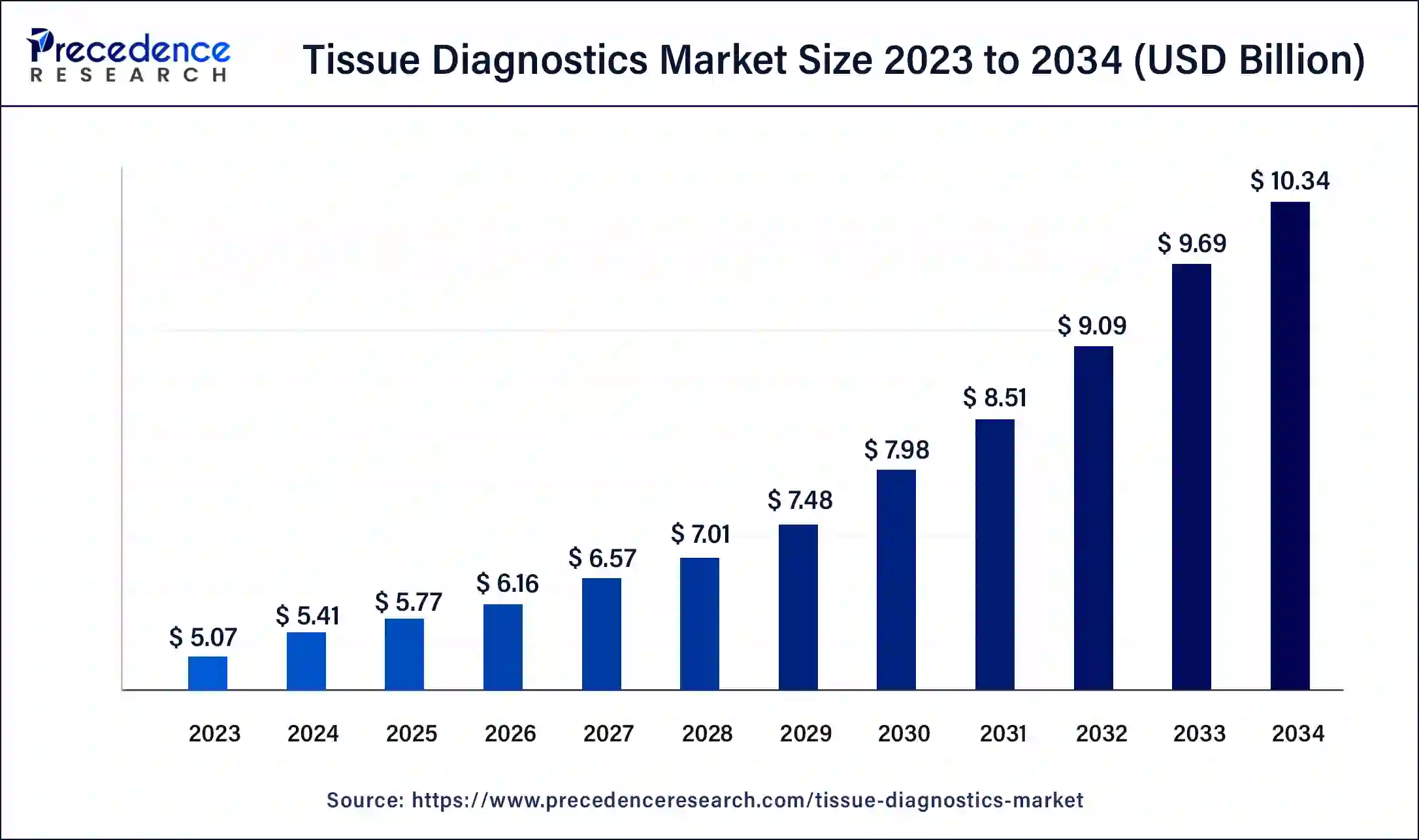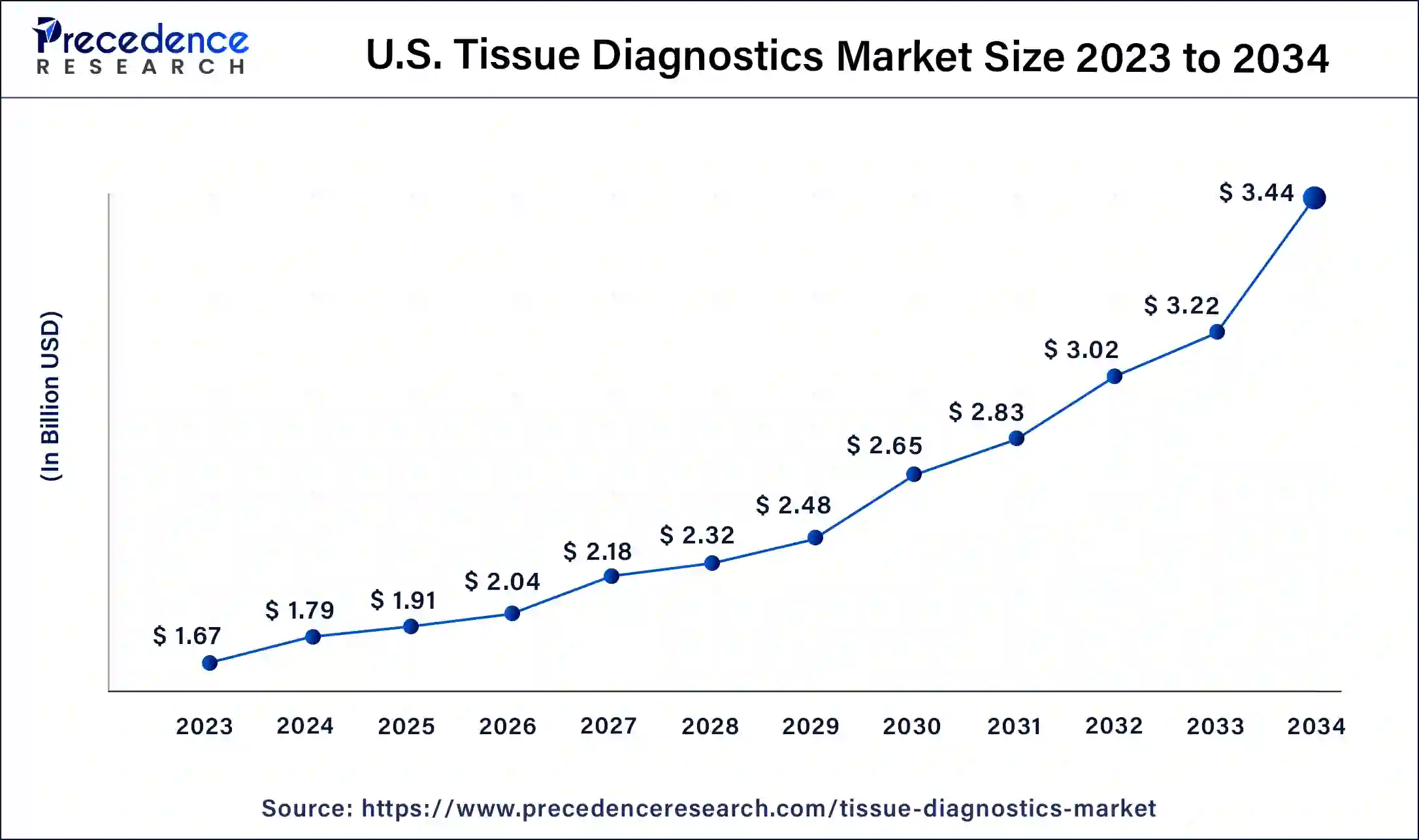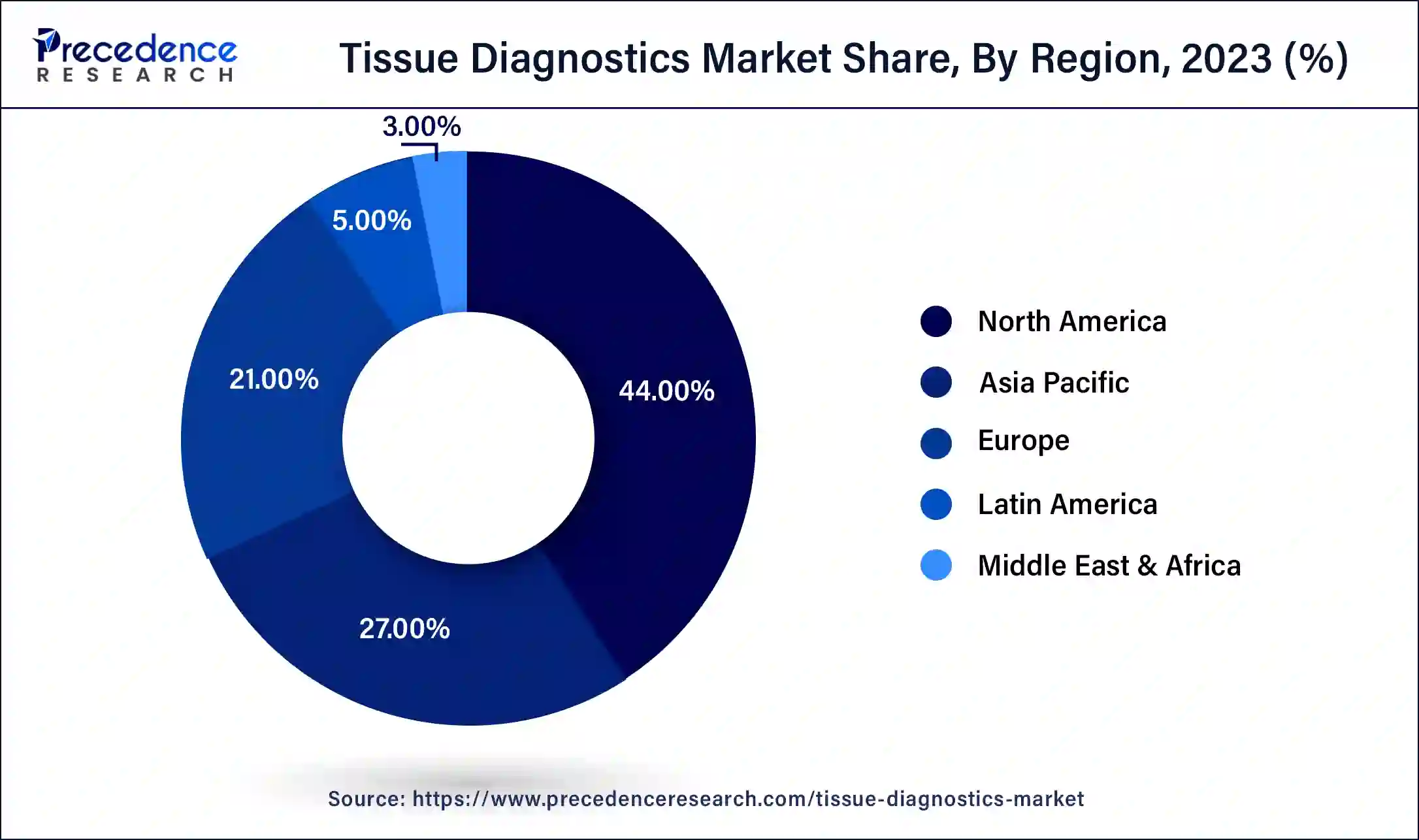January 2025
The global tissue diagnostics market size was USD 5.07 billion in 2023, calculated at USD 5.41 billion in 2024 and is projected to surpass around USD 10.34 billion by 2034, expanding at a CAGR of 6.7% from 2024 to 2034.
The global tissue diagnostics market size accounted for USD 5.41 billion in 2024 and is expected to be worth around USD 10.34 billion by 2034, at a CAGR of 6.7% from 2024 to 2034. The North America tissue diagnostics market size reached USD 2.23 billion in 2023.

The U.S. tissue diagnostics market size was estimated at USD 1.67 billion in 2023 and is predicted to be worth around USD 3.44 billion by 2034, at a CAGR of 6.8% from 2024 to 2034.

North America dominated the global tissue diagnostics market and accounted for the largest revenue share in 2023. The growth is attributed to, an increasing geriatric population, and the raising prevalence of cancer among people is one of the major factors driving the tissue diagnostics market in this region. The presence of various community events leads to reduce cancer patients & increases the demand for cancer detection enhancements in the market for tissue diagnostics.
In addition, the Control Research Network and Cancer Prevention is an event by the domestic centers to prevent and control various diseases which emphasize on cancer prevention in North America. However, Modified drug basically relies on the use of human tissue for the growth of advanced tests. A rise in advanced technologies and healthcare IT systems in the clinical routine has significantly enhanced modified medicine, which drives the use of the tissue diagnostics market. The Medicine Enterprise in the United States enhances the personalized pharmaceutical industry.

Asia Pacific region is expected to hold a significant CAGR during the forecast period. The growth of this region is contributed to, access to a variety of tissue diagnostic tests offered by international industries has increased, which has helped to grow the tissue diagnostic market in this region. For instance, in 19 April 2019, Genecast and HalioDx SAS contracted for the commercialization of the Immunoscore diagnostic trials in China. Due to this program, the availability of this product has increased for cancer patients in china.
A tissue diagnosis treatment is a process that detects diseases in a patient's body through diagnostics and prevents further disorders such as cancer, tumors, biopsy, and other diseases. The increasing Geriatric population and rising prevalence of cancer among people has witnessed a high demand and rapid growth in the tissue diagnostics market. Tissue diagnosis plays a vital role in detecting cancer. The diagnosis treatment acts as one of the best standard procedures with the help of technology advancements such as increasing use of automated tissue-based diagnostic systems by the researchers which helps them to perform in-time diagnosis that detects early-stage cancer and other diseases. North America is expected to hold large market share revenue during the forecast period.
| Report Coverage | Details |
| Growth Rate from 2024 to 2034 | CAGR of 6.7% |
| Market Size in 2023 | USD 5.07 Billion |
| Market Size in 2024 | USD 5.41 Billion |
| Market Size by 2034 | USD 10.34 Billion |
| Base Year | 2023 |
| Forecast Period | 2024 to 2034 |
| Largest Market | North America |
| Fastest Growing Market | Asia Pacific |
| Segments Covered | By Application, By Product, By End-User |
| Regions Covered | North America, Europe, Asia-Pacific, Latin America, Middle East & Africa |
Increasing prevalence of cancer among people driving the tissue diagnostics market
The increasing prevalence of cancer disease among people in developed regions is driving the growth of the tissue diagnostics market. Cancer is a dense disease that creates through the various stages of carcinogenesis procedures involving various trials. As a result, there are different obstacles along with a cancer diagnosis, therapy, and prognosis. However, cancer is one of the most common causes of death globally. According to the World Health Organization, it is found that more than 10 million people died in 2020 due to cancer. But if the cancer is detected early stage the mortality rate can be reduced. As a result, cancer screening and early detection is done by tissue diagnosis treatment, a process that helps in the detection of various biomarkers and proteins that assist in the identification of cancer. Laboratory tests, imaging, biopsy, genetic tests, and endoscopy are some of the common utilized cancer diagnostic tests. The increasing number of tissue diagnostic tests helps to boost the market growth.
Lack of skilled professionals hampering the growth of tissue diagnostic market.
The limited skilled professional staff is a major factor in tissue diagnostic laboratories across emerging regions which is hindering the growth of the market, Moreover, a lack of awareness about tissue diagnosis systems in hospitals and laboratories leads to mistakes in the test reports and also hampers the market growth. The hospitals need to train people with the new advancement and systems adopted by the clinic for the diagnosis process. For instance, in 2020, in the United Kingdom, 4% of diagnostics laboratories has trained staff to provide their diagnostic processes and daily tasks.
Technological advancement in tissue diagnostics creating ample opportunities in the market
Various new technological advancements and update in tissue diagnostics systems is creating numerous opportunities in the tissue diagnostics market. Advancement in diagnostics treatment for effective diagnostic tests such as Immunohistochemistry, Fluorescence in situ hybridizations creates the opportunity to increase the market in upcoming years. For instance, In September 2017, the University of Texas invented a new way of diagnosis by developing a pen which is a handheld hardware device that can detect cancer in 10 seconds named Mas Spec pen, it is 100 times faster than the present technology. These new devices offer improvement in cancer treatment and reduce mortality which eventually creates new opportunities in the tissue diagnostic market.
Furthermore, the increased number of cancer biomarkers is creating many beneficial opportunities for treating cancer patients through advanced detection technology and devices. The detection of cancer biomarkers has been made possible by technological developments within the field of biotech, and these biomarkers are promoted. As a result, the new diagnostic biomarkers is creating lucrative opportunities for the expansion of the tissue diagnostics market.
Based on the Applications, the global tissue diagnostics market is segmented into Prostate Cancer, Breast Cancer, Lung Cancer, Gastric Cancer, and other Cancers. The breast cancer segment is expected to hold a large revenue share during the forecast period for the global tissue diagnostics market. The growth of this segment is attributed to the increasing prevalence of breast cancer in women worldwide, this causes due to genetic issues and increases in inheritance & family background. According to the World Health Organization, breast cancer disease has infected 2.2 million women globally in 2020, with 6, 80,000 mortalities. This cancer has been detected in 7.9 million women in the last 5 years as of the end of 2020, making it one of the most common cancers caused across the globe. Thus, the increasing prevalence of breast cancer is driving the growth of the global tissue diagnostics market during the forecast period.
However, the prostate cancer segment held a significant revenue share, owing to the advancement in technologies. Biomarker detection has assisted the development of tissue diagnostic tests along with opportunities for market growth.
Based on the Product Insights, the global tissue diagnostics market is segmented into In Situ Hybridization, Immunohistochemistry, Primary and Special Staining, Anatomic Pathology, Digital Pathology & Workflow. The Immunohistochemistry segment accounted for substantial growth during the forecast period. The growth of this segment is backed by, applications in therapeutics, the development of cancer diagnostics, and clinical research organizations (CRO). The Immunohistochemistry segment is mostly favored over conservative enzyme staining methods as it precisely brings differences between various types of tumors While, the conservative methods identify a restricted number of enzymes, tissue structures, and proteins of tumors.
However, the digital pathology segment is projected to witness lucrative growth during the forecast period. The growth of this segment is attributed to, an increase in the integration of whole slide imaging among pathologists. In addition, Whole slide Imaging (WSI) extracts precise features of tumors & calculates every component of these structures and supports cancer detection, and delivers useful medical trials for tumors. Also, Top retailers play a key role in the expansion of the usage of digital technology by delivering advanced and new products. For instance, in 2019, a leading player in microscope optical & imaging technologies Nikon Instruments had launched a digital slide scanning system named OS-15-N in collaboration with OptraSCAN.
Based on the End-User Insights, the global tissue diagnostics market is segmented into Research Laboratories, Hospitals, Contract Research Organizations, and Pharmaceutical Organizations. The Hospital segment is expected to hold the largest revenue share during the forecast period. The growth of this segment is attributed to, the large utility rates and consumption of tissue diagnostic systems by hospitals. Doctors are increasingly shifting to tissue-based diagnostic testing methods from conservative testing because tissue diagnostic tests decrease timelines as related to conventional procedures.
However, hospitals are also working on the basis of agreement strategies for improved disease detection, this factor also boosts the segment growth. For instance, in 2019, the Taipei Veterans General Hospital contracted with Philips to install the IntelliSite Pathology system in the hospital. This contract converted from pathology tissue detection to digital diagnostics in the Taipei Veterans General Hospital.
In addition, the Contract research organizations segment is expected to witness substantial growth during the forecast period. This segment delivers clinical trial services, research support, functions, and manages trials of companies. An increasing number of research studies and clinical trials in cancer therapy has considerably driven the tissue diagnostics market and supported to the acceleration of the growth of the CRO segment.
Segments Covered in the Report
By Application
By Product
By End-User
By Geography
For inquiries regarding discounts, bulk purchases, or customization requests, please contact us at sales@precedenceresearch.com
No cookie-cutter, only authentic analysis – take the 1st step to become a Precedence Research client
January 2025
August 2024
February 2025
June 2024